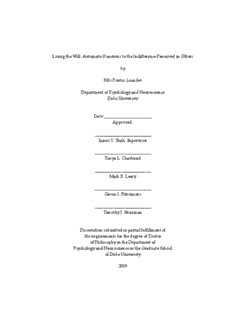
Department of Psychology and Neuroscience Date: PDF
Preview Department of Psychology and Neuroscience Date:
Losing the Will: Automatic Reactions to the Indifference Perceived in Others by Nils Pontus Leander Department of Psychology and Neuroscience Duke University Date:_______________________ Approved: ___________________________ James Y. Shah, Supervisor ___________________________ Tanya L. Chartrand ___________________________ Mark R. Leary ___________________________ Gavan J. Fitzsimons ___________________________ Timothy J. Strauman Dissertation submitted in partial fulfillment of the requirements for the degree of Doctor of Philosophy in the Department of Psychology and Neuroscience in the Graduate School of Duke University 2009 ABSTRACT Losing the Will: Automatic Reactions to the Indifference Perceived in Others by Nils Pontus Leander Department of Psychology and Neuroscience Duke University Date:_______________________ Approved: ___________________________ James Y. Shah, Supervisor ___________________________ Tanya L. Chartrand ___________________________ Mark R. Leary ___________________________ Gavan J. Fitzsimons ___________________________ Timothy J. Strauman An abstract of a dissertation submitted in partial fulfillment of the requirements for the degree of Doctor of Philosophy in the Department of Psychology and Neuroscience in the Graduate School of Duke University 2009 Copyright by Nils Pontus Leander 2009 Abstract Three studies examine individuals’ implicit sensitivity to the absence of motivation perceived in others and how the nature of this sensitivity is moderated by individuals’ own motivational states. Using a subliminal priming paradigm, Study 1 tested a direct perception-behavior link between perceiving indifference in others and applying such indifference towards one’s own pursuits. Study 2 then examined how individuals who are primed in advance with a nonconscious achievement goal show counteraction to the indifference perceived in others. Using a video-based priming paradigm, Study 3 then found that such goal-driven counteraction to indifference occurred only among individuals with higher action control—those who had the ability to sustain goal pursuit after the intention to pursue it had been formed. In contrast, individuals with lower action control in Study 3 were more susceptible to indifference than all other participants, particularly when an achievement goal was made highly active in memory. These influences were found in all three studies to occur largely without participants’ conscious intent or awareness. iv Dedication In memory of Dr. Georg A. Leander. v Contents Abstract ......................................................................................................................................... iv List of Figures ............................................................................................................................... ix Acknowledgements ...................................................................................................................... x 1. Introduction ............................................................................................................................... 1 1.1 Ambitions Lost to the Indifference of Others ............................................................... 1 1.2 Indifference: A perceived or experienced lack of motivation .................................... 5 1.2.1 Evidence of Situationally Cued Indifference ........................................................... 9 1.2.2 Distinguishing Indifference from Other Motivational States ............................. 12 1.3 When Not Doing is Seen: Social Sensitivity to Indifference ..................................... 15 1.3.1 An Indifference of Opinion ...................................................................................... 17 1.3.1 Undermined and Unaware: Priming Indifference Through Direct Trait Activation ............................................................................................................................ 19 1.3.1 Infectious Indifference: A Model of Spreading Apathy ....................................... 22 1.3.1 Step 1: Perceiving an Absence of Motivation .................................................... 24 1.3.2 Step 2: “Catching” an Absence of Motivation................................................... 26 1.4 Reaffirming the Will: On Counteracting the Indifference Perceived in Others .... 27 1.5 The Present Research ..................................................................................................... 30 2. Study 1: Perceiving is for Procrastinating ........................................................................... 32 2.1 Overview ......................................................................................................................... 32 2.2 Method ............................................................................................................................. 35 2.2.1 Participants ................................................................................................................. 35 vi 2.2.2 Procedure .................................................................................................................... 36 2.2.2.1 Indifference Prime.............................................................................................. 36 2.2.2.2 Goal Performance Task ..................................................................................... 37 2.3 Results and Discussion .................................................................................................. 38 3. Study 2: Counteracting Indifference .................................................................................... 41 3.1 Overview ......................................................................................................................... 41 3.2 Method ............................................................................................................................. 43 3.2.1 Participants ................................................................................................................. 43 3.2.2 Procedure .................................................................................................................... 43 3.2.2.1 Achievement Goal Prime .................................................................................. 43 3.2.2.2 Indifference Prime.............................................................................................. 44 3.2.2.3 Goal Performance Task ..................................................................................... 44 3.3 Results and Discussion .................................................................................................. 45 4. Study 3: The Moderating Influence of Volitional Action Control .................................... 49 4.1 Overview ......................................................................................................................... 49 4.2 Method ............................................................................................................................. 53 4.2.1 Participants ................................................................................................................. 53 4.2.2 Procedure .................................................................................................................... 53 4.2.2.1 Achievement Goal Prime .................................................................................. 54 4.2.2.2 Action Control .................................................................................................... 55 4.2.2.3 Video Task .......................................................................................................... 56 4.2.2.4 Indifference Prime.............................................................................................. 57 vii 4.2.2.5 Goal Performance Task ..................................................................................... 57 4.3 Results and Discussion .................................................................................................. 58 5. General Discussion ................................................................................................................. 64 5.1 Implications for Self-Regulation ................................................................................... 67 5.2 Implications for Social Relationships ........................................................................... 69 5.3 Exiting Gracefully: On the Potential Desirability of Indifference ............................ 71 Appendices .................................................................................................................................. 75 Appendix 1 Image Primes used in Studies 1 and 2 ......................................................... 75 Appendix 2 Achievement Goal Prime Used in Study 2 .................................................. 77 Appendix 3 Achievement Goal Prime Used in Study 3 .................................................. 79 Appendix 4 Anagram Task ................................................................................................. 80 Appendix 5 Chair Counting Task Used in Study 3 ......................................................... 81 Appendix 6 Action Control Subscale Used in Study 3 ................................................... 82 Appendix 7 Funneled Debriefing ....................................................................................... 84 References .................................................................................................................................... 85 Biography ..................................................................................................................................... 98 viii List of Figures Figure 1: Number of anagram solutions generated as a function of image type and image context conditions. Higher scores indicate greater goal performance. Adjusted means are reported. ....................................................................................................................................... 40 Figure 3: Study 2: Number of anagram solutions generated as a function of goal priming condition and image priming condition. Higher scores indicate greater goal performance. Adjusted means are reported. ........................................................................... 47 Figure 4: Study 3: Number of chair movements detected as a function of goal priming condition and video type. Higher scores indicate greater goal performance. Adjusted means are reported. .................................................................................................................... 60 Figure 5: Study 3: Number of chair movements detected as a function of goal priming condition, video type, and volitional action control. Higher scores indicate greater goal performance. The black line indicates the minimum number of actual chair movements (23). Predicted values are reported. .......................................................................................... 61 ix Acknowledgements This research was supported by the Duke Interdisciplinary Initiative in Social Psychology, directed by David Neal; Rick Hoyle of Psychology and Neuroscience; the Fuqua School of Business Behavior Lab, directed by Gavan Fitzsimons; the Social Psychology Program, directed by Mark Leary; and the members of the Shah Lab. I thank Jim Shah, Tanya Chartrand, and Wendy Wood for their invaluable advice and encouragement over the course of my graduate career. I also thank my loving wife, Rain, and devoted parents, Ulrika and Arthur. x
Description: